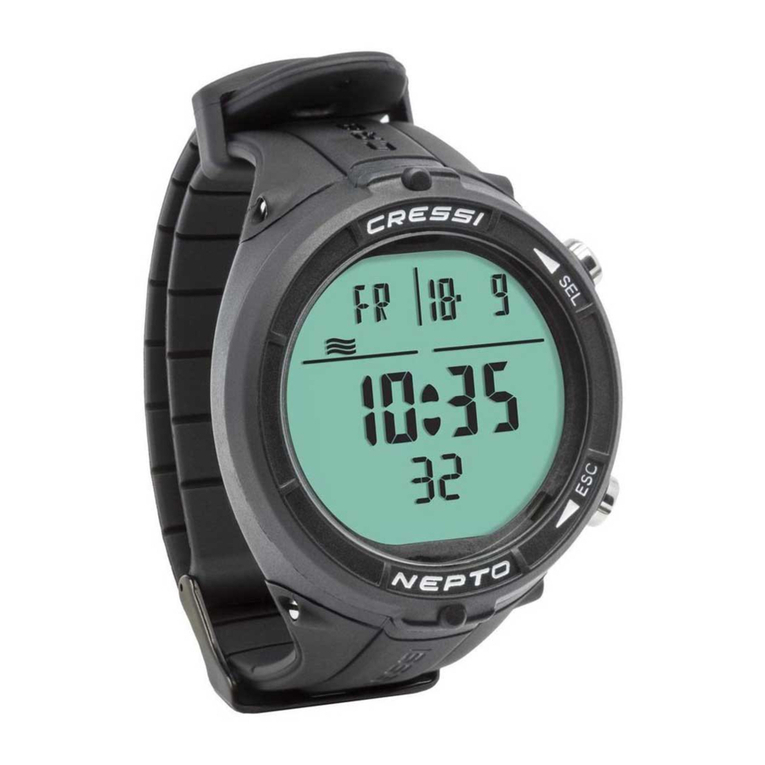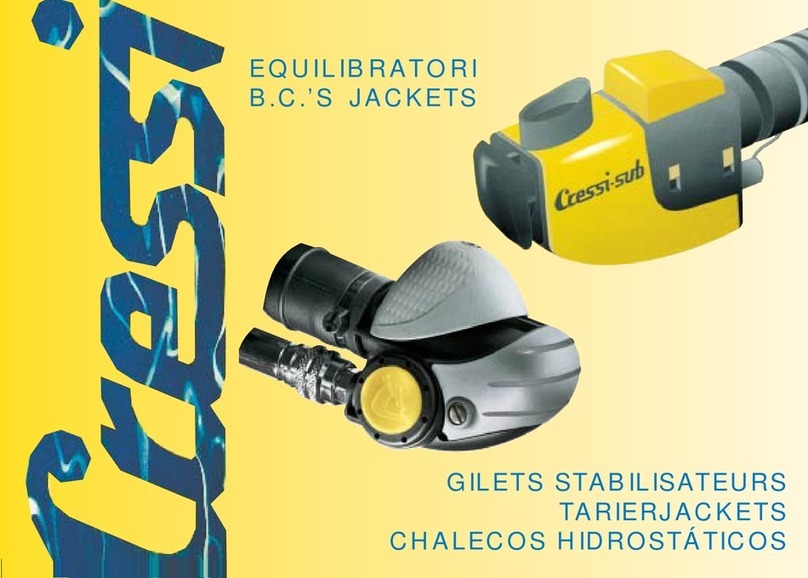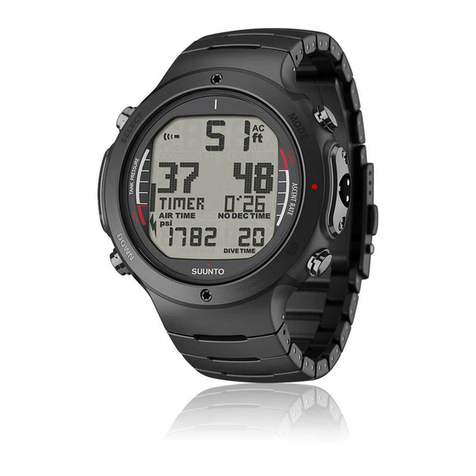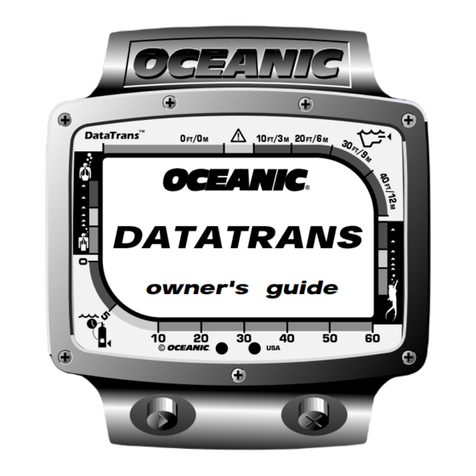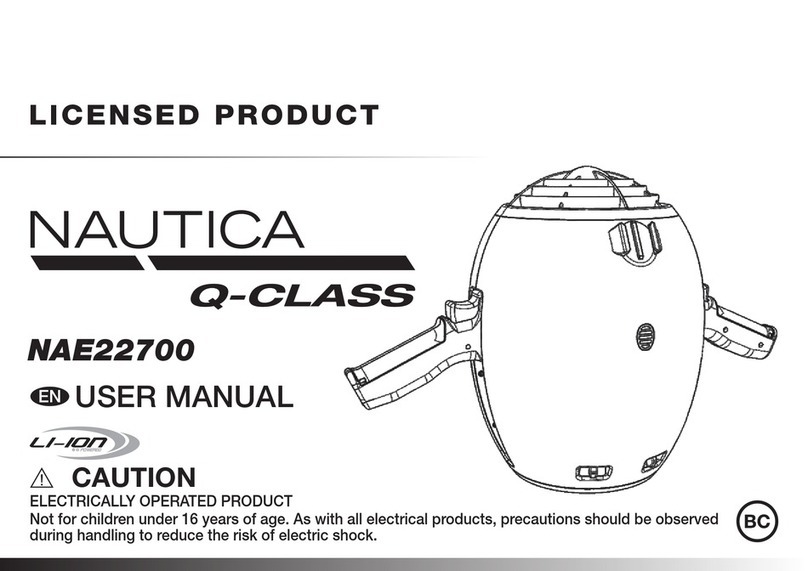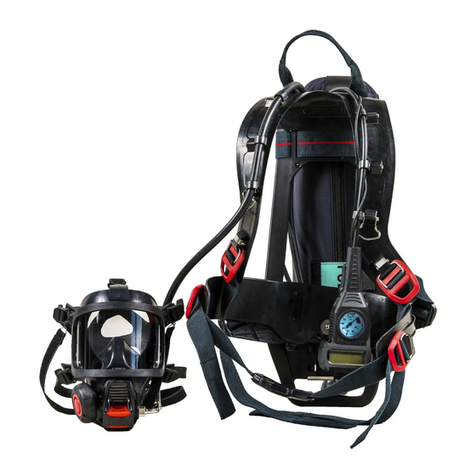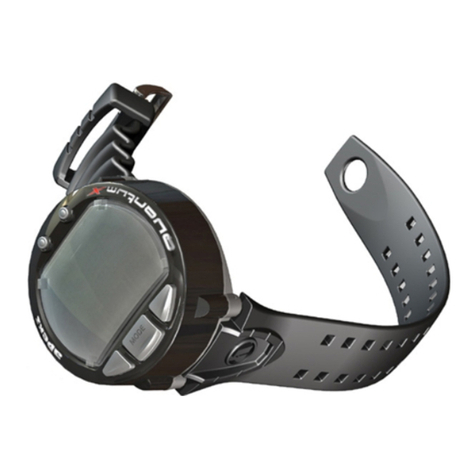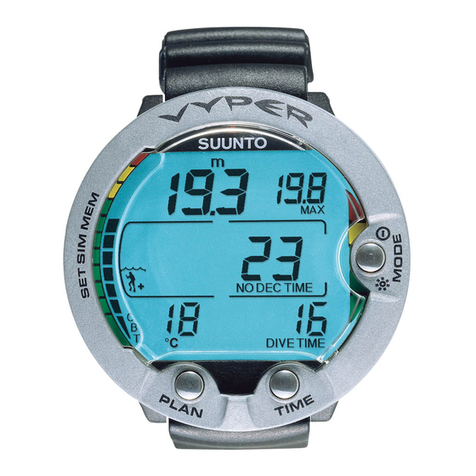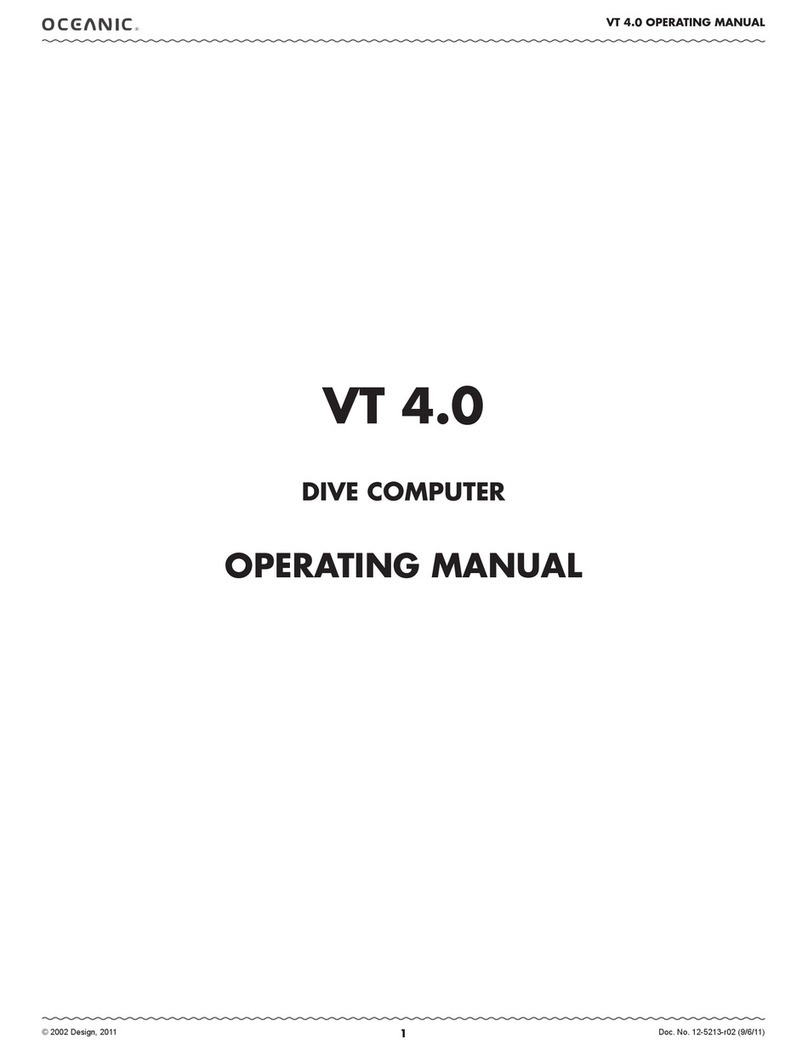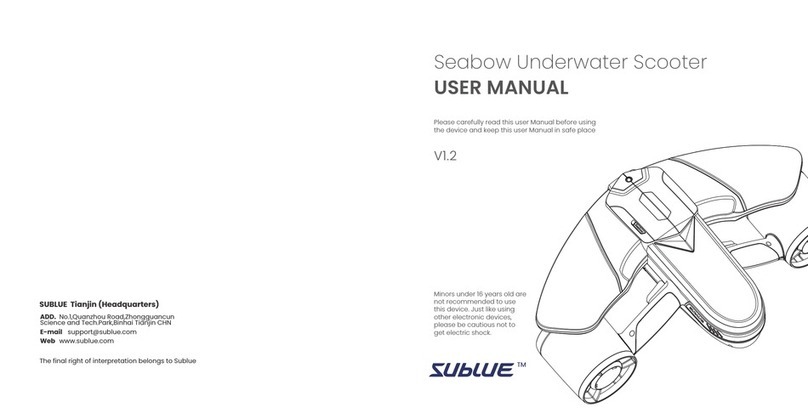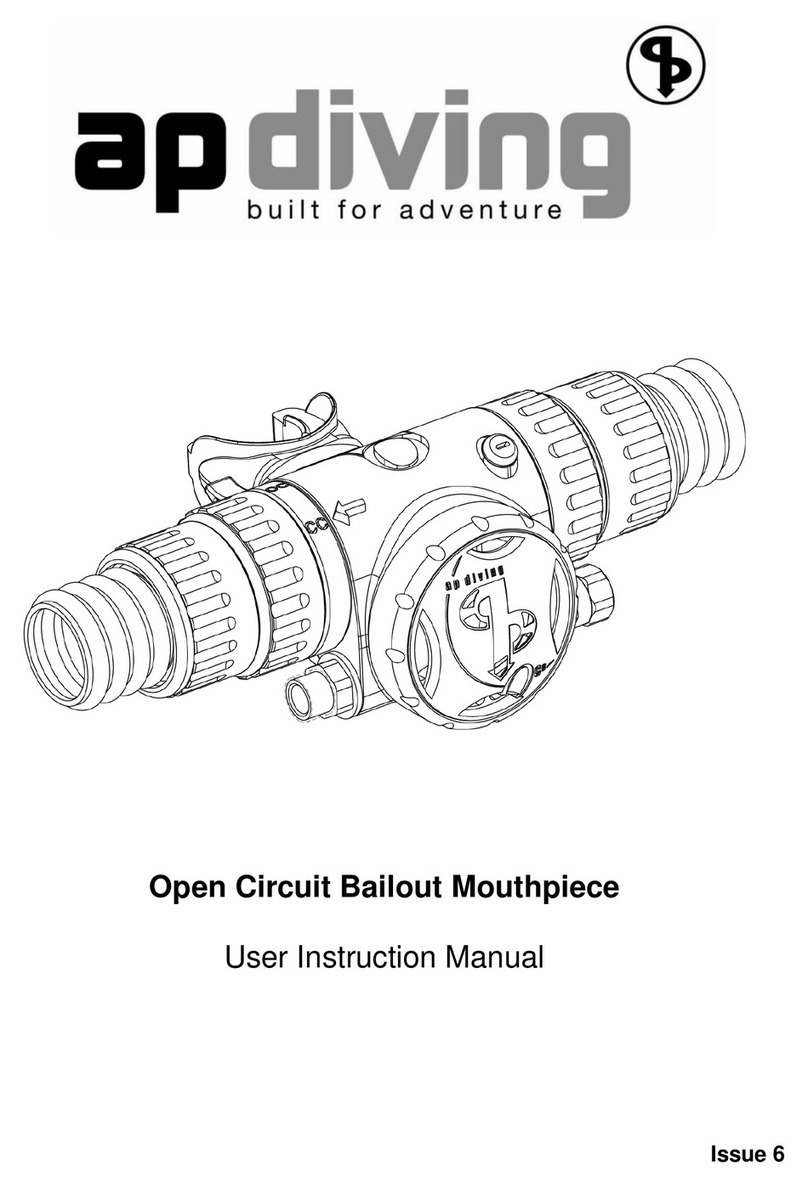Cressi DESERT Manual

Manuale d’uso
Direction for use
Manuel d’instructions
Bedienungsanleitung
Manual de istrucciones
D’ISTR ZIONI M TE STAGNA
DRY S ITS
COMBINAISON ETANCHE
TROCKENTA CHANZÜGE
TRAJES SECOS
Via Gelasio Adamoli, 501 - 16165 - Genova - Italia
Tel. +39 010 830.79.1 - Fax +39 010 830.79.220
info@cressi-sub.it • www.cressi.com rev_02_2016
www.cressi.com

MANUALE MUTE STAGNE C ESSI SUB
Il presente manuale viene redatto in ottemperanza alle disposi-
zioni della direttiva 89/686/CEE e alle norme nazionali che rece-
piscono la norma armonizzata EN 14225-2:2005.
INT ODUZIONE
Questo manuale descrive l’uso, la manutenzione ed i rischi rela-
tivi all’uso delle mute stagne per immersione subacquea.
Leggetelo attentamente e per intero comprendendo appieno
tutte le note prima di usarla.
DESC IZIONE
La caratteristica di una muta stagna è quella di isolare completa-
mente il corpo umano dall’acqua creando una protezione termi-
ca adeguata al fine di rendere più confortevole l’immersione. Il
passaggio dell’acqua è impedito da speciali giunture del tessuto
e da particolari guarnizioni sugli arti e sul collo. Si indossa attra-
verso una particolare cerniera che una volta chiusa non consen-
te il passaggio dell’acqua. Allo scopo di compensare l’aumento
o la diminuzione della pressione interna dell’aria dovuto alla
profondità, viene immessa o espulsa aria tramite due valvole
poste sul petto e sul braccio sinistro.
CONDIZIONI D’IMPIEGO
Le mute stagne Cressi sono realizzate seguendo processi pro-
duttivi ed utilizzando materiali che le rendono molto affidabili e
durature. Allo scopo di non pregiudicare la loro qualità e l’incolu-
mità personale è tuttavia consigliabile attenersi a determinate
condizioni di impiego.
• Nonostante una muta stagna sia prodotta per effettuare
immersioni in acque a bassa temperatura esiste il rischio di
lesioni dovute a una riduzione delle funzioni fisiologiche per
raffreddamento. Temperature dell’acqua inferiori a 21°c (70°F)
costituiscono acque fredde. Temperature dell’acqua inferiori
a 5°c (40°F) costituiscono acque gelide. Immergersi in acque
gelide è molto pericoloso e necessita di attrezzatura, adde-
stramento, preparazione e procedure speciali.
• Si raccomanda di non utilizzare la muta in ambienti contami-
nati o con elevate concentrazioni di idrocarburi. Il contatto con
benzine o lubrificanti durante le normali operazioni che si
effettuano in un’imbarcazione, ad esempio, potrebbero infat-
ti pregiudicarne l’integrità.
• È importante inoltre dedicare la muta all’uso specifico per la
quale è stata prodotta evitando qualsiasi genere di impiego
diverso dalla pura protezione termica in immersione.
• Evitare sempre urti e abrasioni soprattutto quando immersi.
ATTENZIONE
• Questa muta deve essere utilizzata solo da indi-
vidui che hanno ricevuto uno specifico addestra-
mento per il suo uso o che siano accompagnati
da un istruttore certificato. Prima di usare questo
prodotto in acqua libera si consiglia di prendere
pratica con tutte le sue funzioni in un’ambiente a
bacino delimitato (piscina). Usare l’equipaggia-
mento che si userebbe in acque aperte.
• Prima di effettuare immersioni è comunque fon-
damentale per la propria sicurezza accertarsi di
aver effettuato tutte le procedure di emergenza
contemplate da corsi di specialità. Una volta bre-
vettati è comunque indispensabile fare pratica ed
immergersi regolarmente. Non rispettare queste
indicazioni può portare a pericolose ascensioni
incontrollate o a perdite di controllo dell’assetto.
Le conseguenze potrebbero essere molto gravi
per l’incolumità personale.
• Non superare mai la massima profondità prevista
dal brevetto di immersione posseduto.
• Non utilizzare la muta come dispositivo di galleg-
giamento o di salvamento in quanto essa non può
1

garantire il mantenimento della testa fuor d’acqua.
• Come ausilio al galleggiamento in superficie e
per la propria sicurezza, utilizzare un giubbetto
equilibratore con sistema di gonfiaggio indipen-
dente. La sua funzione è quella di aiutare al gal-
leggiamento ma non sostituisce un dispositivo di
galleggiamento o di salvamento in quanto non
può garantire il mantenimento della testa fuor
d’acqua.
• Muta stagna e giubbetto equilibratore non sono e
non devono essere dei sostituti al nuoto.
• Non utilizzare la muta con sistemi di zavorramen-
to privi di dispositivi di sgancio rapido.
• È indispensabile conoscere la propria attrezzatu-
ra e tutte le procedure di emergenza che sono
attinenti ad essa.
• Si raccomanda di leggere il manuale istruzioni di
tutta l’attrezzatura utilizzata con la muta stagna.
• Non immergersi con attrezzatura che non funzio-
na come dovrebbe. ivolgersi sempre ad un cen-
tro autorizzato per la risoluzione dei problemi.
• Non immergetevi mai da soli. Immergersi con un
compagno che conosca bene il funzionamento
della vostra muta stagna e della vostra attrezza-
tura. Fate sempre in modo che a terra o sulla
barca ci siano persone in grado di aiutarvi in
caso di emergenza.
• Siate consapevoli dei vostri limiti e non supera-
teli.
• Prima di indossare la muta è opportuno vestirsi
con un sottomuta termico adatto al tipo di immer-
sione che si intende eseguire.
MATE IALI E COMPONENTI
Le mute Cressi sono realizzate utilizzando dei fogli di neoprene
o trilaminato. La loro funzione è quella di isolare dall’acqua ester-
na l’epidermide riducendo la dispersione di calore. I fogli vengo-
no uniti tra di loro tramite un incollaggio speciale e/o delle cucitu-
re non passanti che impediscono le infiltrazioni dell’acqua. Per
facilitare l’indossamento viene inserita una cerniera stagna
metallica.
Cerniera Stagna
La cerniera stagna, grazie alla sua ampia apertura, consente
un’agevole vestizione della muta ed un’efficace barriera all’am-
biente esterno. Essa, grazie ai suoi denti, unisce due lembi gom-
mosi che stretti fra loro impediscono il passaggio dell’acqua. Può
essere posizionata trasversalmente sulla parte frontale del corpo
oppure orizzontalmente dietro le spalle e presenta una patta
sovrastante allo scopo di migliorare il comfort e proteggerla da
possibili urti o abrasioni. Per aprire e chiudere la cerniera è con-
sigliabile farsi aiutare dal proprio compagno.
Frusta di bassa pressione
La frusta di bassa pressione serve per condurre l’aria alla valvo-
la di carico della muta stagna. Deve essere collegata ad un’u-
scita di bassa pressione del tipo LP UNF 3/8” del primo stadio
dell’erogatore oppure ad un’altra fonte d’aria a bassa pressio-
ne. La pressione massima deve essere di 15 bar (225 psi.). Si
connette alla valvola tramite un attacco di tipo rapido identico a
quello delle fruste degli equilibratori. Per connetterla alla valvola
spostare indietro l’apposito terminale, spingerla nell’apposito
alloggiamento fino a fine corsa e poi rilasciare. Controllare l’av-
venuta connessione facendo una leggera trazione. Per discon-
netterla spostare indietro l’apposito terminale e rimuovere. La
frusta può essere connessa o disconnessa anche in pressione
e sott’acqua.
2

Valvola di Carico
La valvola di carico è posizionata sul petto della muta ed è la sor-
gente d’aria per il suo gonfiaggio. Deve essere connessa alla fru-
sta di bassa pressione. Azionando il pulsante di carico posto
lateralmente o nel centro si può immettere aria all’interno della
muta. Essa non deve far entrare acqua o lasciare uscire aria se
non connessa alla frusta.
Valvola di Scarico
La valvola di scarico elimina l’eccesso d’aria che si accumula
all’interno della muta stagna senza far entrare l’acqua. E’ posi-
zionata vicino alla spalla nella parte superiore del braccio sinistro.
Il deflusso dell’aria può avvenire manualmente o automatica-
mente:
1. anualmente occorre premere la sommità della sua calotta
con la mano destra tenendo il braccio alzato verso la superficie.
2. Automaticamente quando l’aria raggiunge una determinata
pressione all’interno della muta. Questa pressione può esse-
re variata avvitando (aumenta la pressione alla quale essa si
aprirà) e svitando (diminuisce la pressione alla quale essa si
aprirà) la calotta esterna. Questa regolazione determina
anche la quantità di aria necessaria per mantenere un certo
assetto base.
P OTEZIONE TE MICA
La protezione termica che una muta è in grado di garantire
dipende da alcuni importanti fattori:
• Temperatura dell’acqua
• orfologia dell’individuo
• Fisiologia dell’individuo
• Affaticamento
• Proprietà termiche del materiale
Alcuni di essi esulano dalle caratteristiche del prodotto e quindi è
importante conoscere la propria predisposizione alle variazioni di
temperatura dell’ambiente. Nonostante una muta stagna sia pro-
dotta per effettuare immersioni in acque a bassa temperatura
esiste il rischio di patologie dovute a una riduzione delle funzioni
fisiologiche per raffreddamento. Temperature dell’acqua inferiori
a 21°c (70°F) costituiscono acque fredde. Temperature dell’ac-
qua inferiori a 5°c (40°F) costituiscono acque gelide. Immergersi
in acque gelide è molto pericoloso e necessita di attrezzatura,
addestramento, preparazione e procedure speciali.
ATTENZIONE
Durante l’attività subacquea si possono verificare
delle pericolose situazioni in cui il corpo si surri-
scalda o si raffredda eccessivamente (ipertermia e
ipotermia). Evitare quindi con muta indossata in
superficie, durante le stagioni estive o nelle zone
tropicali, una prolungata esposizione al sole asso-
ciata o meno ad affaticamento fisico. Altrettanto
dicasi per lunghe permanenze in acque fredde od
esposizioni in superficie a climi invernali. Si consi-
glia, in abbinamento con la muta stagna, di utilizza-
re sempre sottomuta termici, calze termiche, guan-
ti spessi e cappuccio (se non integrato) in ogni
situazione nella quale la temperatura dell’acqua
possa esporre il subacqueo al rischio di ipotermia.
3

Sottomuta termico
Per proteggere il subacqueo dal raffreddamento, che potrebbe
causare una riduzione delle funzioni fisiologiche, è estremamen-
te importante indossare in modo corretto un sottomuta termico.
Questo deve essere adatto alle condizioni metereologiche, alla
temperatura dell’acqua al tipo di attività che si intende effettuare
ed alla fisiologia/morfologia dell’individuo.
Cappuccio
Il cappuccio è molto importante in quanto protegge dal freddo
un centro nevralgico come il capo. Nel caso sia separato dalla
muta considerate uno spessore minimo di 5 mm e assicurarsi
che avvolga il collo senza essere eccessivamente largo.
Guanti
È importante tenere calde le mani in modo da poter controllare
la propria attrezzatura durante l’immersione. Utilizzare uno spes-
sore adatto alla temperatura dell’acqua. Se questa è gelida si
consigliano a tre dita e con spessore di 7 mm.
INDOSSAMENTO
È molto importante che la muta si adatti correttamente alla cor-
poratura del subacqueo fasciandolo senza stringere. Essa non
deve mai essere di intralcio ai normali movimenti e sopprattutto
alla respirazione. Accertarsi di riuscire ad unire le mani sopra la
testa, di toccare la punta dei piedi e di potersi piegare sulle
ginocchia senza particolari impedimenti. È molto importante che
essa non crei ostacoli all’espansione della cassa toracica e si
consiglia quindi di simulare una respirazione profonda. Deve
essere posta attenzione anche alla tenuta a livello di collo, polsi e
caviglie, che deve essere adeguata ma senza stringere eccessi-
vamente. Verrebbe infatti bloccato l’afflusso di sangue alle mani,
ai piedi ed alla testa creando perdite di sensibilità o svenimenti.
Una muta troppo larga contrariamente lascerà l’aria libera di
muoversi all’interno della stessa creando un flusso che può por-
tare a seri problemi d’assetto. La taglia della muta deve essere
scelta in modo da consentire agevoli movimenti ma nel contem-
po evitare che si formino tasche d’aria eccessivamente volumi-
nose. Per determinare la più corretta corrispondenza fra le pro-
prie misure e le taglie standard delle mute Cressi consultare la
tabella sottostante relativa all’identificazione delle taglie.
4

5
TABELLA TAGLIE UOMO
S/II/48
M/III/50
L/IV/52
XL/V/54
XXL/VI/56
60/68
70/78
kg
80/88
90/98
100/108
132/150
154/172
ibs
176/194
198/216
220/238
164/170
169/175
cm
174/180
179/185
184/190
65/67
67/69
inch
69/71
71/73
73/75
78/83
86/91
cm
94/99
102/107
110/115
31/33
34/36
inch
37/39
40/42
43/45
65/71
71/77
cm
77/83
83/89
89/95
25/28
28/30
inch
30/33
33/35
35/37
78/83
84/89
cm
90/95
96/101
102/107
31/33
33/35
inch
35/37
38/40
40/42
40/42
41/43
EU
42/44
43/45
44/46
7/8
7,5/8,5
UK
8/10
8.5/11
10/11,5
7,5/8,5
8/9
US
8,5/10,5
9/11,5
10,5/12
PESO ALTEZZA PETTO VITA FIANCHI PIEDETAGLIA
TABELLA TAGLIE DONNE
XS/I/42
S/II/44
M/III/46
L/IV/48
XL/V/50
47/52
53/58
kg
59/64
64/70
70/80
104/115
117/128
ibs
130/141
141/154
154/176
157/162
162/167
cm
167/172
172/177
177/182
62/64
64/66
inch
66/68
68/70
70/72
77/82
82/87
cm
87/92
92/97
97/102
30/32
32/34
inch
34/36
36/38
38/40
56/61
60/65
cm
64/69
68/73
72/77
22/24
24/26
inch
25/27
27/29
28/30
83/87
87/91
cm
91/95
95/99
99/103
32/34
34/36
inch
36/37
37/39
39/41
37/39
38/40
EU
39/41
40/42
41/43
4,5/6,5
5,5/7
UK
6,5/7,5
7/8
7,5/8,5
5/7
6/7,5
US
7/8
7,5/8,5
8/9
PESO ALTEZZA PETTO VITA FIANCHI PIEDETAGLIA

La procedura per indossare corettamente la muta è la seguente:
1. Controllare che le guarnizioni in neoprene o in latex siano
prive di screpolature, tagli o segni d’usura.
2. Controllare l’operatività della cerniera assicurandosi che
scorra senza impedimenti e che sia libera da corpuscoli
estranei.
3. Togliere anelli, bracciali, orologi o collane che potrebbero
danneggiare le guarnizioni in neoprene od in lattice, graffiare
la pelle o danneggiarsi.
4. Rigirare il tronco della muta e piegarlo sulle gambe dalla vita
in giù.
5. Se possibile sedersi, infilare un piede nella gamba della muta
tenendola per il tessuto a livello del polpaccio e passare il
piede sino alla scarpetta in neoprene, poi calzare il resto della
gamba.
6. Ripetere l’operazione con l’altra gamba.
7. Sollevarla sino a che il cavallo non sia nella posizione corretta.
8. Sistemare le bretelle sulle spalle e regolarle in modo da man-
tenere il cavallo ben sospeso.
9. Inserire il primo braccio ed aiutandosi con l’altra mano calzar-
lo sino al polsino stagno avendo cura di non danneggiarlo
con le unghie. Sistemarlo bene sul polso in modo che non
presenti delle pieghe. Eventualmente applicare talco o acqua
saponata per agevolare le operazioni.
10. Ripetere l’operazione con l’altro braccio.
11. Una volta infilate le braccia portare il collare stagno in prossi-
mità della testa ed allargarlo leggermente impugnando la
parte superiore con entrambe le mani (dita all’interno e polli-
ci all’esterno). Posizionare il collare in modo che sia conforte-
vole e che aderisca bene al collo. Nel caso di collare in neo-
prene liscio all’esterno si raccomanda di risvoltarlo all’interno
per circa 7-10 cm in modo che la parte liscia sia a contatto
con il collo.
12. Chiedere al proprio compagno di chiudere la cerniera sta-
gna. A tal fine alzare le braccia a livello delle spalle e piegarle
ai gomiti in modo che i pugni si fronteggino. In questo modo
la cerniera viene sufficientemente tesa per consentire un’a-
gevole operazione di chiusura che dovrà avvenire con una
trazione decisa e continua prestando attenzione che non si
impigli alle varie parti. Assicurarsi che il cursore arrivi in battu-
ta contro il fermo per evitare aperture accidentali o infiltrazio-
ni d’acqua. Controllare che sia correttamente chiusa.
13. Eliminare l’eccesso di aria rannicchiandosi ed inserendo deli-
catamente due dita per mano nel collare oppure ruotando la
valvola di scarico in senso antiorario sino a che non si noti il
passaggio dell’aria.
14. Indossare il cappuccio se separato dalla muta.
15. Indossare la zavorra ed il gruppo bombola con il giubbetto
equilibratore.
16. Collegare la frusta alla valvola di carico controllando la sua
tenuta.
ALLE GIE
I materiali che compongono una muta in rari casi possono crea-
re dei fenomeni allergici. Prima di acquistarla o di utilizzarla si rac-
comanda di accertarsi di non essere allergici a neoprene, polie-
stere o nylon, gomma butilica, lattice o poliuretano. In caso di
dubbi consultate un medico.
CONT OLLI P E-IMME SIONE
Prima di ogni immersione assicurarsi delle buone condizioni della
muta controllando l’integrità delle giunture, del tessuto e delle
guarnizioni. Verificare che la cerniera sia funzionante ed integra,
assicurarsi che fra i suoi denti non vi siano corpi estranei, pulirla e
lubrificarla se necessario. Controllare attentamente il meccani-
smo di connessione della frusta alla valvola ed assicurarsi che
non vi siano danni o corpuscoli estranei che ne impediscano
l’aggancio e la tenuta. Controllare lo stato della parte in gomma
della frusta.
6

7
Controlli prima dell’ingresso in acqua
Controllare la corretta connessione della frusta e che questa non
interferisca all’accesso di altra attrezzatura. Assicurarsi del cor-
retto funzionamento delle valvole di carico e di scarico immet-
tendo e scaricando aria. Chiedere al compagno di controllare la
chiusura della cerniera.
ATTENZIONE
Per gonfiare la muta non usare altri gas oltre all’a-
ria. L’uso di miscele Nitrox (iperossigenate) può
essere causa di incendio e di esplosione. Con l’uso
dell’Argon vi è il rischio che questo penetri all’inter-
no della maschera a granfacciale e del sistema
respiratorio attraverso il cappuccio. La respirazio-
ne dell’Argon comporta un grossissimo rischio nar-
cotico rispetto all’Azoto in quanto di peso moleco-
lare superiore.
ATTENZIONE
L’entrata in acqua con la cerniera aperta può cau-
sare lesioni o annegamento dato l’immediato alla-
gamento della muta. Accertarsi della sua perfetta
chiusura soprattutto quando si è in prossimità di
acque fonde o su una barca.
IN IMME SIONE
Con l’aumentare della profondità e quindi della pressione la muta
e l’aria interna subiscono uno schiacciamento che ne varia con-
siderevolmente la capacità di galleggiamento. A seguito di que-
sto fenomeno quindi occorre ricordare che in profondità
l’assetto di un subacqueo tende a diventare negati-
vo e che la maniera più sicura per compensarlo è quella di utiliz-
zare un Jacket associando nel contempo, se necessario, una
leggera iniezione d’aria nella muta per evitare il fastidioso effetto
ventosa. Si raccomanda quindi di frequentare un corso di adde-
stramento presso una scuola subacquea riconosciuta. Occorre
anche ricordare che la quantità di zavorra da utilizzare è molto
importante e in linea di massima, deve consentire al subacqueo
di mantenere un assetto neutro con la bombola a pressione
riserva alla quota di -3m.
Un altro fenomeno molto importante legato all’au-
mento della profondità ed allo schiacciamento della
muta e dell’aria interna è la perdita della capacità
isolante e conseguentemente un maggior raffredda-
mento del corpo umano. Lo strato protettivo assottiglian-
dosi a causa della pressione che subisce perde parte delle sue
caratteristiche consentendo un maggior scambio termico tra
uomo ed ambiente. I subacquei che prevedono di rimanere per
lunghi periodi di tempo in profondità, allo scopo di scongiurare
una pericolosa ipotermia, devono fare attenzione al raffredda-
mento che subisce il loro corpo e tutelarsi equipaggiandosi con
dei sottomuta o con mute di spessore maggiore.
In Immersione
1. Essere sicuri di aver indossato propriamente tutta l’attrezza-
tura.
2. Chiudere la valvola di scarico ruotandola in senso orario ed
immettere un po’ di aria prima di entrare in acqua.
3. Gonfiare l’equilibratore.
4. Entrare in acqua prima con i piedi.
5. Aprire la valvola completamente ruotandola in senso antiora-
rio e sollevare la parte superiore del braccio in modo che
questa sia nella posizione più alta possibile. L’aria uscirà ed
inizierà la discesa a piedi in giù.
6. Dopo essere scesi di un paio di metri chiudere la valvola ruo-
tandola in senso orario per un quarto di giro ed insufflare aria
per diminuire la compressione della muta sul corpo.
7. Durante la discesa ricordarsi di insufflare aria di tanto in tanto
per diminuire la compressione della muta.
8. Dopo il raggiungimento della quota stabilita insufflare attenta-
mente aria nell’equilibratore sino al raggiungimento dell’as-
setto neutro.
9. Quando si decide di risalire scaricare l’equilibratore senza
dimenticarsi di intervenire anche sulla muta stagna.

10. Durante la risalita la valvola di scarico farà uscire automatica-
mente l’aria in eccesso quando alzeremo la parte superiore
del braccio sinistro. Di tanto in tanto, se necessario, si può
effettuare uno sfiatamento addizionale: aprire completamen-
te la valvola in senso antiorario oppure premerla manual-
mente sulla sua calotta. Risalire lentamente a 10m/min.
11. Al raggiungimento della superficie chiudere completamente
la valvola ruotandola in senso orario ed immettere una
modesta quantità di aria. Gonfiare l’equilibratore per consen-
tire un facile galleggiamento.
ATTENZIONE
• A seguito di una risalita rapida o di una pallonata
esiste il rischio di lesioni letali per malattia da
decompressione o embolia gassosa arteriosa.
Non tentare quindi di utilizzare la vostra muta
come dispositivo di sollevamento. La perdita
della zavorra può causare una risalita rapida ed
incontrollata.
• Il gonfiaggio della muta durante l’immersione ha
il solo scopo di creare un’ulteriore barriera al
freddo aumentando lo strato isolante tra la pelle
e l’acqua. Quando la muta viene compressa dal-
l’acqua e va in “ventosa”, infatti, si noterà un’im-
mediata sensazione di raffreddamento del corpo.
• Per evitare pericolose risalite incontrollate a
testa in giù evitare di immettere troppa aria nella
muta e di posizionarsi con il busto ad una quota
inferiore ai piedi. Per ogni minimo accenno di
eccessivo gonfiaggio nella zona dei piedi, portar-
li immediatamente verso il basso rannicchiando-
si e scaricare subito la muta. Se questa posizio-
ne fosse necessaria ricordarsi di scaricare pre-
ventivamente la muta. Un eccessivo gonfiaggio
nella zona dei piedi può portare anche alla perdi-
ta delle pinne.
• Se la valvola di gonfiaggio inizia a rilasciare aria
in modo incontrollato, staccare immediatamente
la frusta e risalire.
• Nel caso non si riesca a gonfiare la muta o se la
muta perde massicciamente aria utilizzare il
jacket per ristabilire un assetto neutro e risalire
immediatamente.
• Nel caso di una pericolosa pallonata, come ultima
possibilità, liberarsi della zavorra e cercare di
controllare la risalita.
• Nella remota possibilità in cui la valvola di scari-
co dovesse bloccarsi si consiglia di far uscire
aria dalle guarnizioni dei polsi o del collo allar-
gandole con le mani e rivolgendole verso la
superficie. Fare attenzione a non dilatarle ecces-
sivamente in quanto uscirà aria ma entrerà
acqua.
Svestizione
1. Una volta in superficie disconnettere la frusta di bassa pres-
sione dalla valvola di carico e procedere alla svestizione delle
bombole e del jacket. Togliere il cappuccio nel caso questo
fosse staccabile.
2. Facendosi aiutare dal compagno aprire con attenzione la
cerniera.
3. Allargare leggermente il collare stagno impugnando la parte
superiore con entrambe le mani (dita all’interno e pollici all’e-
sterno). Sollevare e sfilare la testa facendo attenzione a non
danneggiarlo con le unghie.
4. Per rimuovere le guarnizioni dai polsi inserirvi delicatamente
due dita unite della mano opposta sino alla fodera interna
della manica. Facendo pinza tra queste ed il palmo tirare con
attenzione la manica ed il polsino e contemporaneamente
sfilare la mano (attenzione alle unghie). Togliere la manica e
ripetere l’operazione con l’altro braccio.
5. Togliere il resto della muta preferibilmente seduti.
8

CONT OLLI POST IMME SIONE
Dopo ogni immersione verificare che la muta non abbia subito
danni e nell’eventualità effettuare al più presto la riparazione. Se
trattasi di interventi particolari si consiglia di recarsi presso un
rivenditore autorizzato Cressi. Dopo ogni immersione la vostra
muta dovrà sistematicamente essere controllata e preparata
per la prossima.
PULIZIA E DISINFEZIONE
Pulire e sciacquare con acqua dolce dopo ogni immersione.
Prima di procedere chiudere la cerniera e appendere la muta
rovesciata con i piedi in alto. Sciacquarla lasciando che l’acqua
scorra verso il basso ed eliminare sabbia e detriti aiutandosi con
una soffice spugna. Lasciarla asciugare all’ombra con la cernie-
ra aperta per consentire che l’umidità interna possa essere eli-
minata. L’umidità creata dal sudore corporeo e da piccole infil-
trazioni infatti potrebbe dar vita a cattivi odori. Una volta asciutta
appenderla ad una gruccia che abbia una superficie di appoggio
molto ampia e priva di spigoli. Gli stivaletti in gomma devono
essere appoggiati a terra. Periodicamente si consiglia di effet-
tuare un accurato lavaggio a mano con una soluzione di sapone
neutro. Non lavare a secco, non lavare in lavatrice, non usare
candeggina e non stirare.
ATTENZIONE
Non usare mai benzina, trielina, acquaragia, petro-
lio o solventi simili per pulire la muta stagna. Il con-
tatto con queste sostanze deve essere assoluta-
mente evitato e nel caso avvenga si consiglia di
sciacquare e lavare immediatamente la parte inte-
ressata.
MANUTENZIONE
Un’accurata cura e manutenzione vi aiuterà a mantenere la
vostra muta durevole nel tempo e le vostre immersioni comode
ed asciutte. Effettuate regolarmente sia la manutenzione pre-
ventiva che le riparazioni. L’inadeguata manutenzione potrebbe
causare lesioni gravi o morte ed è quindi raccomandato rivolger-
si ad un servizio assistenza autorizzato Cressi per il controllo e la
manutenzione della muta, delle valvole e della frusta. Fatelo con
maggiore frequenza in caso di uso continuo e prolungato.
Nel caso in cui la vostra muta necessiti interventi o riparazioni
non menzionati in questo manuale si raccomanda di rivolgersi
presso un rivenditore o un centro assistenza autorizzato Cressi.
Manutenzione del tessuto
È sempre bene controllare che il tessuto non presenti tagli e
perforazioni e nel caso si consiglia di chiuderle con del mastice
per neoprene o con l’apposita colla. Fare attenzione alle giuntu-
re e controllare che siano integre. Prestare particolare attenzio-
ne a ginocchia e gomiti.
Manutenzione della cerniera stagna
Un’appropriata cura e pulizia della cerniera è molto importante in
quanto è uno degli elementi più importanti per un buon funzio-
namento. Essa deve essere pulita periodicamente per rimuove-
re sabbia, detriti e residui di paraffina che ne possano ostacola-
re il funzionamento e la tenuta. Procedere aprendola completa-
mente e con uno spazzolino pulire gli spazi tra i denti. Attorno ad
9
LAVA E A MANO
F EDDO
NON LAVA E A SECCO
NON CANDEGGIA E
ASCIUGA E APPESO
ASCIUGA E ALL’OMB A
NON ASCIUGA E A
MACCHINA
NON STI A E

essi vi sono delle superfici liscie che accostate impediscono
all’acqua di entrare: pulirle e passarle con un velo di vaselina. Nel
caso fosse difficoltoso azionarla chiuderla e lubrificarla passando
della cera di paraffina per tutta la sua lunghezza sulla parte ester-
na metallica. Si raccomanda di non usare lubrificanti siliconici
spray.
Manutenzione dei polsini e del collare
I polsini ed il collare di tenuta non richiedono particolare manu-
tenzione se non quella di mantenerli correttamente puliti e pro-
tetti da un velo di talco. Nel caso presentino tagli o buchi chiuderli
con del mastice oppure recarsi in un centro autorizzato Cressi
per la sostituzione.
Manutenzione delle valvole
La valvola di scarico richiede una piccola manutenzione. Dopo
ogni immersione è indispensabile sciacquarla molto attentamen-
te con acqua dolce e controllare che non vi siano residui che
impediscano l’uso e ne compromettano la tenuta della mem-
brana. Nel caso rimuoverli.
Effettuare le stesse operazioni per la valvola di carico controllan-
do in particolar modo l’attacco rapido e il pulsante di carico.
Sciacquare e pulire anche la frusta controllandone l’integrità.
Kit di riparazione
Alcuni modelli di mute stagne comprendono un kit di riparazione
per piccoli interventi. Nel caso la muta abbia infiltrazioni d’acqua
cercare il buco e poi marcare la zona con un gessetto. Pulire
molto bene l’area con sapone e acqua tiepida e successiva-
mente asciugare. Stendere la colla ed applicare la toppa eserci-
tando una buona pressione. Lasciare asciugare.
CONSE VAZIONE E T ASPO TO
Conservare la muta appesa ad una gruccia che abbia una
superficie di appoggio molto ampia e priva di spigoli con gli sti-
valetti o i calzari appoggiati a terra. I polsini ed il collare devono
essere cosparsi di talco e la cerniera lasciata aperta. Per evitare
pericolose muffe controllare che sia ben asciutta e pulita, spe-
cialmente all’interno. Il luogo deve essere all’ombra, fresco ed
asciutto. Non piegarla ed evitare la compressione del tessuto.
Evitare locali dove vi siano generatori di ozono motori elettrici o
solventi chimici. Trasportarla in una borsa per attrezzatura
subacquea che ne consenta un certo agio. Piegarla in modo che
le maniche e la cerniera avvolgano il resto dell’indumento senza
angoli netti ma in modo che seguano un arco di ampio raggio.
Evitare il contatto con oggetti appuntiti o affilati.
SMALTIMENTO
Smaltire le mute attenendosi scrupolosamente alle norme in
vigore nel paese in cui si effettua tale operazione.
10

INST UCTION MANUAL FO D Y SUITS
This manual was written in compliance with the provisions of
89/686/CEE directions and with the Italian rules following the
EN 14225-2:2005 rule.
INT ODUCTION
This manual describes use, care and risks related to diving dry
suits. Please read it wholly and carefully, taking care to under-
stand thoroughly all its notes before using your suit.
DESC IPTION
The main peculiarity of a dry suit is insulating the human body
completely from the water, therefore protecting it by the cold in
order to make diving more comfortable.
The water is prevented from getting in by special joints in the
fabric and seams on the arms, legs and around the neck. It is
possible to put it on thanks to a special watertight zip fastener. In
order to balance the internal pressure increase or decrease due
to the depth, air is introduced or discharged by means of two
valves placed on the chest and on the left arm.
CONDITIONS OF USE
Cressi watertight dry suits are made by production processes
and using materials that make them highly reliable and lasting.
In order not to damage their quality and your personal safety we
recommend you though to follow determinate conditions of use.
• Although a dry suit is produced in order to carry out dives in
low temperature water, the risk always exists of damages due
to a decrease of physiologic functions because of the cold.
Water temperatures lower than 21° C (70° F) mean cold
water. Water temperatures lower than 5° C (40° F) mean
freezing water. Diving in freezing water is highly dangerous
and requires special equipment, training and procedures.
• We recommend not to use your dry suit in contaminated
environments or presenting high concentrations of hydrocar-
bons. The contact with petrol or oils during the usual opera-
tions carried out on board, for instance, could affect your
suit’s integrity.
• oreover, we recommend to use your dry suit only for the
specific use it was produced for and to avoid any use other
than thermic protection during the dive.
• Always avoid impacts or abrasions, especially when in water.
WA NING
• This dry suit must be worn only by individuals
who have attended a specific training course for
its use or who are accompanied by a licensed
instructor. Before wearing your dry suit in open
water, we recommend to get used to all its func-
tions in a delimitated area (swimming-pool). Use
the equipment you would use in open water.
• Before any dive, it is always recommended for
your own safety to have carried out all the emer-
gency procedures foreseen by special training
courses. After getting your licence, it is always
recommended to practice and dive regularly.
Should you not follow this indications, you might
be led to dangerous unchecked resurfacing or
balance control losses. The consequences might
be very dangerous for your own personal safety.
• Never exceed the maximum depth reported in
your diving licence.
• Do not use your dry suit as a floating or rescuing
device, since it does not keep your head out of
water.
• As a floating device on surface and for your own
safety, use a balancing self-inflating jacket. Its
function will be helping by floating: it won’t thou-
gh replace a floating or rescuing device, since it
does not keep your head out of water.
• Dry suit and balancing jacket do not and must not
replace swimming.
• Do not wear your dry suit with any ballast
11

systems which are not equipped with rapid relea-
se devices.
• It is unavoidable to know your own equipment and
every related emergency procedure thoroughly.
• We recommend to read the directions for use of
the whole equipment to be used with your dry suit.
• Never dive wearing any equipment which does
not work as it should. Always apply to an autho-
rized centre for any problem.
• Never dive by yourself. Always dive with a part-
ner which is well acquainted with your dry suit
and equipment. Always be sure there are people
ashore or on board which are able to help you in
case of emergency.
• Be aware of your own limits and do not exceed
them.
• Under your dry suit, you should always wear a
thermic under-suit.
MATE IALS AND COMPONENTS
Cressi dry suits are made of neoprene or tri-laminated sheets.
Their function is to insulate the skin from the water, reducing the
dispersion of warmth. The sheets are bound with each other by
means of a special glue and/or stitches which avoid water infil-
trations. A watertight metallic zip fastener is inserted to make
easier to put on the suit.
Watertight zip fastener
The watertight zip fastener allows putting on the suit more easily,
thanks to its wide opening, and guarantees a reliable protection
from the external environment. By means of its teeth, it unites
two rubber edges which prevent the water from getting in. It
may be placed in front crosswise or behind your shoulders hori-
zontally; an overlapping flap improves the comfort and protects
it from impacts and abrasions.
We recommend to ask your partner for help by opening and clo-
sing your zip fastener.
Low pressure pipe
The low pressure pipe leads air to the dry suit’ s valve. It must be
connected to one of the LP UNF 3/8” low pressure hole of the
regulator’ s first stage or to another low pressure air source. The
maximum pressure must be 15 bar (225 psi.). It is connected to
the valve by means of a quick connection like the b.c.d`s hose.
To connect the pipe to the valve, move back the end, push the
hose onto the nipple and release it. Check the connection by sli-
ghtly pulling the hose. To disconnect the hose, pull back the
sleeve end and remove it. The hose can be connected or
disconnected even when under pressure and underwater.
Inlet valve
The inlet valve is the air source to inflate the dry suit and it is pla-
ced on its chest.
It must be connected to the low pressure port. You can intro-
duce air inside your dry suit by pressing the inlet button placed
either on the side or in the centre. The valve must not let water
in or discharge air if it is not connected to the hose.
Outlet valve
The outlet valve discharges the air in excess which may have
gathered inside the dry suit, without letting water in. It is placed
on the upper left arm close to the left shoulder. You can dischar-
ge air either manually or automatically:
1. When manually, you have to press its cap with your right hand
keeping your arm raised towards the surface.
2. The air will be discharged automatically, when it reaches a
particular pressure inside the suit. Such pressures can be
limited by screwing and unscrewing the outside cap: turning
it clockwise will open at a greater internal pressure; anti
clockwise will open at a lower internal pressure. Such adjust-
ments determine the quantity of air necessary to keep a
basic balance.
12

THE MIC P OTECTION
The thermic protection guaranteed by your dry suits depends on
the following main factors:
• Water temperature
• Diver’s morphology
• Diver’s physiology
• Diver’s weariness
• aterial’s thermic properties
Some of them do not depend on the product’s peculiarities: the-
refore, it is important to be aware of one’s own predisposition to
the environmental changes of temperature.
Although a dry suit is produced to dive in low temperature water,
the risk exists of pathologies due to a decrease of physiologic
functions because of the cold. Water temperatures lower than
21° C (70° F) mean cold water. Water temperatures lower than
5° C (40° F) mean freezing water. Diving in freezing water is
highly dangerous and requires special equipment, training and
procedures.
WA NING
During dives, dangerous situations may occur,
when the body gets excessively warm or cold
(hyperthermic and hypothermic conditions).
Therefore, by wearing your dry suit on surface in
the summer or in tropical areas, avoid standing
long in the sun, both when you are more or less
tired. In the same way, avoid staying long in cold
water or on surface by wintry climates. We recom-
mend to wear your wet suit always together with
thermic under-suits, thermic socks, thick gloves
and hood (if not included in the dry suit), in any
situation when the water temperature might expo-
se the diver to the risk of hypothermic conditions.
Thermic under-suit
In order to protect the diver from the cold, that might cause his
physiological conditions to be reduced, it is very important to
wear a thermic under-suit correctly. This must be adequate to the
meteorological conditions, to the water temperature, to the kind
of dive you are going to carry out and to your own physiology.
Hood
The hood is very important, since it protects your head from the
cold. If your dry suit does not include a hood, please consider
one with a minimal thickness of 5 mm and be sure it envelops
your neck without being too loose.
Gloves
It is very important keeping your hands warm, so that you may
always be able to control your equipment during the dive. Use glo-
ves with adequate thickness as to the water temperature. In free-
zing water, we recommend 7 mm thick three-fingered gloves.
HOW TO PUT ON YOU D Y SUIT
It is very important that the dry suit adapts itself to the diver’ s
body correctly, clinging to it without being too tight. Be sure you
are able to unite your hands over your head, to touch your toes
and to bend your knees without any hindrances.
It is very important that the dry suit does not hinder your chest’ s
expansion in any way: we recommend therefore to simulate
deep breathing. You must also pay attention that your suit is
perfectly watertight at your neck, wrists and ankles, without
being too tight. Should your suit be too tight, the blood flow to
your hands, feet and head would be blocked, causing you to
loose sensitivity or to faint. On the contrary, a too loose suit will
let the air flow inside it, inducing a flux that might cause serious
balancing problems. You must choose your suits size so that
you are able to move easily, and too wide air -pockets are avoi-
ded.
In order to choose the Cressi dry suit standard size that most
adapts to your own, please refer to the following table.
13

14
SIZE CHA T MEN’S
S/II/48
M/III/50
L/IV/52
XL/V/54
XXL/VI/56
60/68
70/78
kg
80/88
90/98
100/108
132/150
154/172
ibs
176/194
198/216
220/238
164/170
169/175
cm
174/180
179/185
184/190
65/67
67/69
inch
69/71
71/73
73/75
78/83
86/91
cm
94/99
102/107
110/115
31/33
34/36
inch
37/39
40/42
43/45
65/71
71/77
cm
77/83
83/89
89/95
25/28
28/30
inch
30/33
33/35
35/37
78/83
84/89
cm
90/95
96/101
102/107
31/33
33/35
inch
35/37
38/40
40/42
40/42
41/43
EU
42/44
43/45
44/46
7/8
7,5/8,5
UK
8/10
8.5/11
10/11,5
7,5/8,5
8/9
US
8,5/10,5
9/11,5
10,5/12
WEIGHT HEIGHT CHEST WAIST HIP FOOTSIZE
SIZE CHA T MEN’S
XS/I/42
S/II/44
M/III/46
L/IV/48
XL/V/50
47/52
53/58
kg
59/64
64/70
70/80
104/115
117/128
ibs
130/141
141/154
154/176
157/162
162/167
cm
167/172
172/177
177/182
62/64
64/66
inch
66/68
68/70
70/72
77/82
82/87
cm
87/92
92/97
97/102
30/32
32/34
inch
34/36
36/38
38/40
56/61
60/65
cm
64/69
68/73
72/77
22/24
24/26
inch
25/27
27/29
28/30
83/87
87/91
cm
91/95
95/99
99/103
32/34
34/36
inch
36/37
37/39
39/41
37/39
38/40
EU
39/41
40/42
41/43
4,5/6,5
5,5/7
UK
6,5/7,5
7/8
7,5/8,5
5/7
6/7,5
US
7/8
7,5/8,5
8/9
WEIGHT HEIGHT CHEST WAIST HIP FOOTSIZE

15
Here follows how you are to wear your dry suit correctly:
1. Check the neoprene or latex seams for cracks, cuts or any
other damages.
2. Check that the zip fastener works well, sliding without hin-
drances and is free from any foreign body.
3. Do not wear rings, bracelets, watches or necklaces that
might damage the neoprene or latex seams, scratch the
leather or get damaged themselves.
4. Turn your dry suit’s trunk and fold it on your legs from the
waist downwards.
5. If possible, sit down, put your foot into the suit’s leg holding it
at the level of its calf and push your foot down to the neo-
prene shoe, then put the suit on the rest of your leg.
6. Do the same with your other leg.
7. Lift your dry suit until its crotch is at the right level.
8. Place the braces on your shoulders and adjust them so that
the crotch is well lifted.
9. Put your arm into the sleeve and wear it up to the watertight
cuff, helping yourself with your other hand and paying atten-
tion not to damage it with your fingernails. Adjust it well on
your wrist so that there are no creases. You may apply some
talcum or bath-soap in order to get such operation easier.
10. Do the same with your other arm.
11. After that, lift the watertight collar to the level of your head
and slightly widen it holding its upper part with both your
hands (fingers inside, thumbs outside). Place the collar so
that it clings well and comfortably to your neck. If your collar’s
outside is made of smooth neoprene, we recommend to fold
it inside for about 7-10 cm, so that the smooth side touches
your neck.
12.
Ask your partner to close your zip fastener: raise your arms to
the level of the shoulders and bend them at the elbows so
that your thumbs front each other. In such way, the zip faste-
ner is stretched enough to be easily closed, by way of a strai-
ght continuous pulling, taking care it does not get caught
anywhere. ake sure the slider gets to the stop, in order to
avoid accidental opening or water infiltrations. ake sure it is
correctly closed.
13. Remove the air in excess crouching down and inserting sof-
tly two fingers of both hands into the collar, or turning the
outlet valve anticlockwise, until you can feel the air flux.
14. Wear the hood, if not included in the dry suit.
15. Wear the ballast and the tank with your balancing jacket.
16. Connect the hose to the inlet valve, checking its seal.
ALLE GY
The materials in which a dry suit is made, very seldom cause
allergys. Before buying or wearing it, we recommend to make
sure you are not allergic to neoprene, polyester or nylon, butyl
rubber, latex or polyurethane. If in doubt, please see a doctor.
WHAT YOU MUST CHECK BEFO E A DIVE
Before any dive make sure of your dry suits good conditions,
checking its joints, fabric and seams. Check that the zip fastener
works well and is complete, making sure there is no foreign body
between its teeth, and clean and grease it when necessary.
Check carefully the hoses connecting device to the valve, make
sure there is no damage or foreign body hindering its connection
and seal. Check the condition of the hoses rubber part.
What you must check before getting into the water
Check that the hose is correctly connected and does not hinder
you from reaching for the rest of the equipment.
Check that the inlet and outlet valves work well, by introducing
and discharging some air. Ask your partner to check that your zip
fastener is correctly closed.

16
WA NING
Do not use any gas other than air to inflate your dry
suit. Using Nitrox (hyper-oxygenate mixtures) might
cause fires or explosions. Using Argon you run the
risk it penetrates into your mask and breathing
device through the hood. Breathing Argon implies a
very higher danger of narcotic risk than nitrogen,
since its molecular weight is greater.
WA NING
Getting into water with an open zip fastener might
cause damages or even drowning, since the dry
suit will be flooded at once.
Make sure it is perfectly closed, especially when
you are in open sea or on board.
DU ING A DIVE
As the pressure increases along with the depth, the dry suit and
the inside air undergo a pressure that affects remarkably their
floating capacity.
Therefore, you must always be aware that at certain
depths a diver’s balance tends to become negative:
the safest way to compensate is wearing a jacket and, when
necessary, introducing a small quantity of air into the dry suit, in
order to avoid the uncomfortable squeeze effect. We therefore
recommend to attend a training course at a licensed underwa-
ter diving centre. You should also to remember that the quantity
of ballast to be used is important as well: generally, it must allow
the diver to keep a neutral balance with the reserve tank at the
depth of –3 m.
Another remarkable aspect bound to the increasing
depth and pressure on the dry suit and inside air is the
loss of insulating capacity, causing the human body to
get colder. The protecting layer gets thinner because of the
pressure, and loses part of its peculiarities, allowing a greater ther-
mic interchange between the body and the environment.
Divers who are going to stay long in deep water must pay atten-
tion to their becoming colder and protect themselves by means
of under-suits or thicker dry suits, in order to avoid dangerous
hypothermic conditions.
During a dive
1. ake sure you are wearing the whole equipment properly.
2. Close the outlet valve turning it clockwise, and introduce
some air before getting into the water.
3. Inflate the jacket.
4. Get into the water with your feet first.
5. Open the valve fully turning it anticlockwise and raise the
upper part of your arm, so that it is in the highest possible
position. The air starts flowing out and you may start going
down with your feet first.
6. After descending for about a couple of meters, close the
valve turning it clockwise for a quarter of a turn and introdu-
ce air, in order to reduce the pressure of the dry suit on your
body.
7. During the descent, remember to introduce air from time to
time, in order to reduce the pressure of the dry suit.
8. After reaching the desired depth, introduce air into the jacket
until the balance is neutral.
9. When you decide to surface, discharge the jacket, and do
not forget to do the same with the dry suit.
10. While surfacing, the outlet valve discharges the air in excess
automatically, as you raise the upper part of your left arm.
From time to time and when necessary, you may discharge
more air, by fully opening the valve anticlockwise or pressing
it on the cap. Surface slowly at the rate of 10 mtrs per minute.
11. After reaching the surface, close the valve fully turning it
clockwise and introduce a small quantity of air. Inflate your
jacket to float more easily.

17
WA NING
• Surfacing too rapidly might cause serious dama-
ges and even death. Therefore do not try using
your dry suit as a floating device. Losing your bal-
last may cause a rapid uncontrolled resurfacing.
• Inflating your dry suit during the dive has the only
aim to create a further protection against the
cold, improving the insulating layer between your
skin and the water. When the dry suit is subject
to the water’ s pressure in fact, you will feel at
once the squeeze effect and your body getting
colder.
• In order to avoid dangerous uncontrolled head
down resurfacing, do not introduce too much air
in your suit and keep your trunk at a lower depth
than your feet.
Whenever you get the slightest feeling of too
much air at your feet’ s zone, place them at once
downwards, crouch and discharge your suit.
Whenever you have to take this position, always
remember to discharge your suit. If the feets
zone gets too inflated, you might also loose your
fins.
• If the inflating valve starts introducing air in an
irregular way, disconnect the hose at once and
resurface.
• If you are not able to inflate your dry suit or if it is
losing a lot of air, use your jacket to get back to
a neutral balance and resurface at once.
• In case of bumping, get rid of your ballast and try
checking your resurfacing.
• In the remote possibility that the outlet valve is
blocked, we recommend to discharge air from
the wrist or neck seams, widening them with
your hands and bending them towards the surfa-
ce. Take care not to widen them too much, since
this will cause the air to flow out, but the water
will get in as well.
How to take off your dry suit
1. On surface, disconnect the low pressure pipe from the inlet
valve and start taking off your tanks and jacket. Take off your
hood, if not included in the suit.
2. Ask your partner to help you opening your zip fastener.
3. Slightly widen your watertight collar, holding its upper part
with both your hands (fingers inside, thumbs outside). Raise
it and get your head out, taking care not to damage it with
your fingernails.
4. Remove the wrists seams by inserting softly two fingers of
your opposite hand down to the sleeve inside lining. Holding
sleeve and cuff between your fingers and palm, pull them
carefully and in the meanwhile take your hand out (be care-
ful with your fingernails). Take off your sleeve and do the
same with your other arm.
5. Take off the rest of your dry suit by being seated.
WHAT YOU MUST CHECK AFTE A DIVE
After any dive, check your suit for any damage: in presence of
any, have it repaired at once. In case of particular operations, we
recommend to refer to an authorized Cressi centre. After any
dive, your suit must be checked and got ready for the next one
carefully and systematically.

18
CLEANING AND DISINFECTION
Clean and rinse your dry suit in fresh water after every dive.
Before doing so, close the zip fastener and hang your dry suit
head down and feet up. Rinse it letting the water flow
downwards and remove sand or dirt by means of a soft sponge.
Let it dry in the shadow leaving the zip fastener open, in order to
dry off the inside dampness. The dampness caused by sweat
and small infiltrations might otherwise originate bad smells.
When the suit is dry, hang it on a steady and edgeless dress han-
ger. Place your rubber shoes on the floor. From time to time, we
recommend to wash them carefully by hand using a neutral
soap solution. No dry clean, machine wash, bleach or iron.
WA NING
Never use petrol, trichloroethylene, turpentine or
the like to clean your suit.
The contact with such products must be absolutely
avoided: should it occur, we recommend to rinse
and wash the part at once.
CA E AND MAINTENANCE
A careful care of your suit will help you to keep it longer, and your
dives will be dry and comfortable.
Regularly carry out both preventive care and repairs. An impro-
per care might cause dangerous damages and even death: we
therefore recommend to refer to an authorized Cressi assistan-
ce centre for any check and repair of your suit, valves and pipe.
Do it more frequently in case of continuous and prolonged use.
If your wet suit needs interventions or repairs which are not
described in this manual, please refer to an authorized Cressi
retailer or assistance centre.
COLD HAND WASH
NO D Y CLEAN
NO BLEACH
LET IT D Y ON
A HANGE
DO NOT D Y IN
THE SUN
NO MACHINE D YING
NO I ON

19
Fabric care
You should always check the fabric for any cuts or perforations:
in case, we recommend to stop them with neoprene putty or
the special glue. Take care of the joints, checking them for any
damage. Take particular care of the knees’ and elbows’ zones.
Watertight zip fastener care
It is very important to keep and clean the zip fastener properly,
since it is one of the main elements allowing the wet suit to work
well.
It must be cleaned periodically to remove sand and dirt that
might hinder its working and seal. Open it completely and clean
the spaces between its teeth with a brush. Around the teeth,
smooth spaces, when united, prevent the water from getting in:
clean them and apply a film of vaseline. Should you find it difficult
to open or close it, close it and grease its metallic outside part
with paraffin wax, along its whole length. We recommend NOT
to use silicon sprays.
Cuffs and collar care
The seal cuffs and collar do not require any particular care, other
than keeping them cleaned protected with a thin layer of talc and
out of direct sunlight. Should they present cuts or holes, stop them
with a glue or refer to an authorized Cressi centre to replace them.
Valves care
The outlet valve requires small care. After any dive, always rinse
it very carefully in fresh water and check it for any residuals that
might hinder its working or damage its seal. In such case, remo-
ve them completely. Do the same with the inlet valve, checking
carefully its quick connection and inlet button. Rinse and clean
the hose as well, checking it for cuts and holes.
epair kit
Some models are equipped with a repair kit for small interven-
tions. Should the dry suit present water infiltrations, look for the
hole and mark the area with chalk. Clean the area perfectly with
soap and warm water and rinse it. Apply the glue and the patch,
and press well. Let it dry.
STO AGE AND T ANSPO T
Keep your wet suit on a dedicated drysuit hanger.
Apply talcum on the cuffs and collar, leave the zip fastener open.
In order to avoid dangerous moulds, the suit must be perfectly
dry and clean, especially inside.
Keep in a dark, cool and dry place. Do not fold your suit, avoid
any compression of the fabric. Avoid the presence of ozone
generators, engines or chemical solvents.
Carry it in a sufficiently large bag for underwater equipment. Fold
it so that its sleeves and zip fastener enwrap the rest, not at
clean angles but at wide range arch. Avoid the contact with
sharp tools.
DISPOSAL
Always comply with the law of the country in which you dispose
of your wet/dry suit.
This manual suits for next models
11
Table of contents
Languages:
Other Cressi Diving Instrument manuals
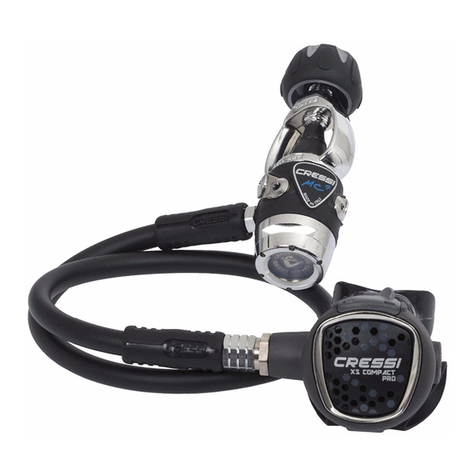
Cressi
Cressi MC9 S.C. Manual
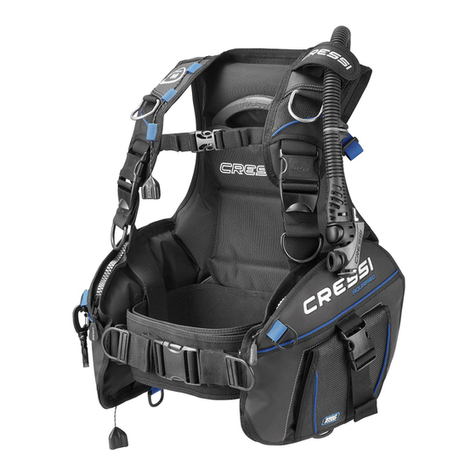
Cressi
Cressi Aquapro Manual

Cressi
Cressi DRAKE User manual
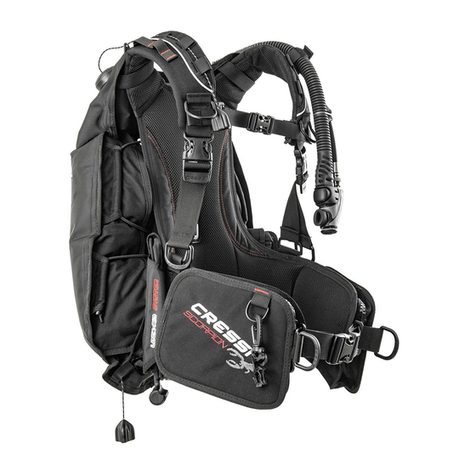
Cressi
Cressi Scorpion Manual

Cressi
Cressi Archimede User manual
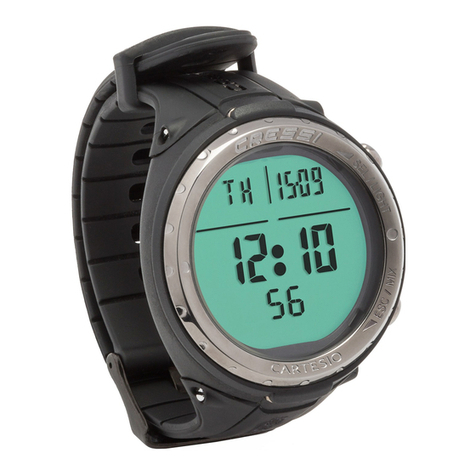
Cressi
Cressi CARTESIO User manual

Cressi
Cressi GIOTTO User manual
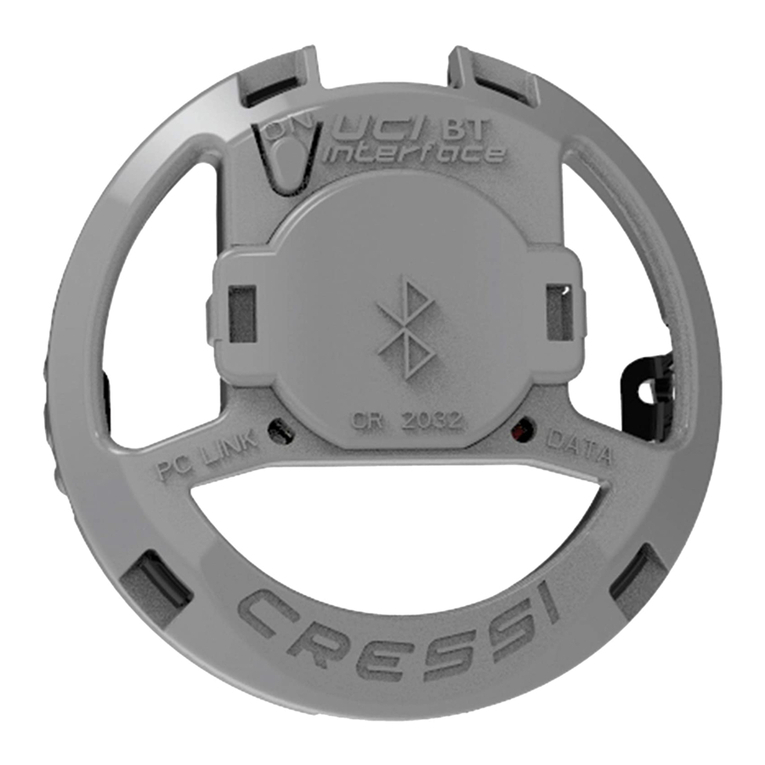
Cressi
Cressi Bluetooth Interface User manual

Cressi
Cressi Leonardo Manual
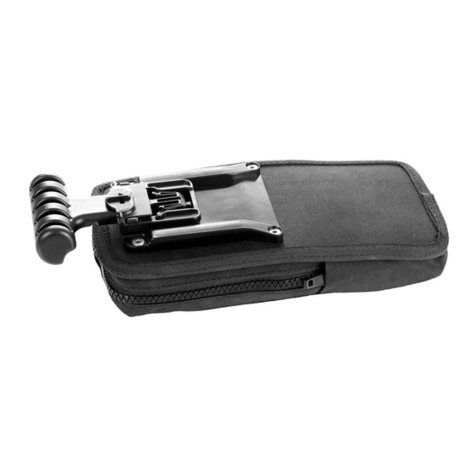
Cressi
Cressi IZ750094 User manual
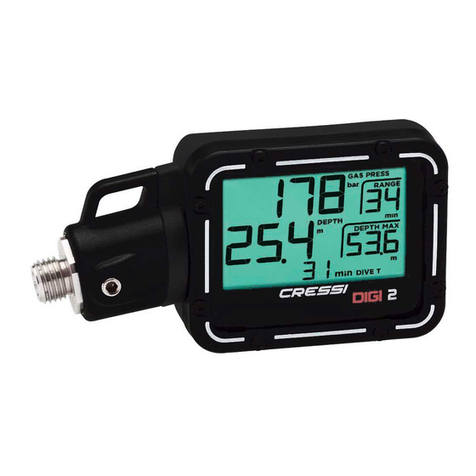
Cressi
Cressi DIGI 2 User manual
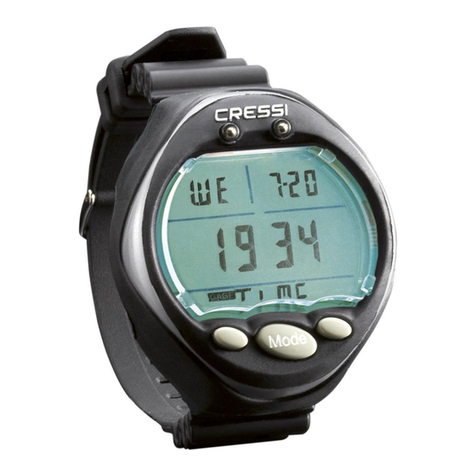
Cressi
Cressi Archimede II User manual

Cressi
Cressi AQUAWING Manual

Cressi
Cressi DIGI 2 User manual

Cressi
Cressi CARTESIO GOA User manual
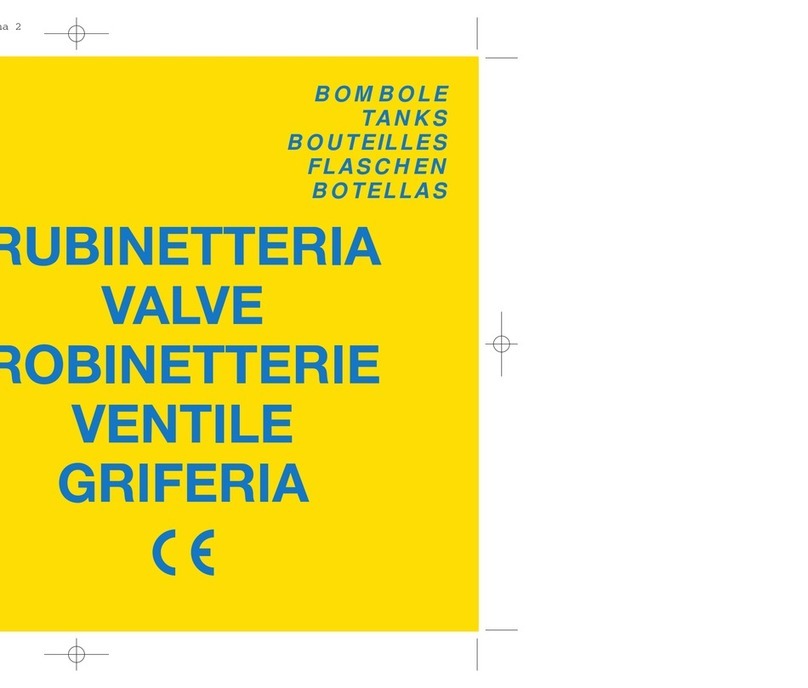
Cressi
Cressi PORTER User manual

Cressi
Cressi MC9 S.C. Manual

Cressi
Cressi Leonardo Manual
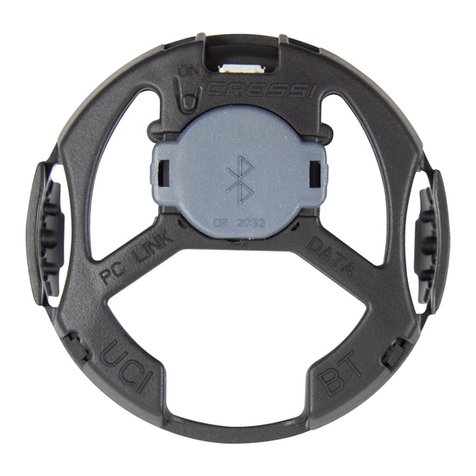
Cressi
Cressi BT Interface User manual
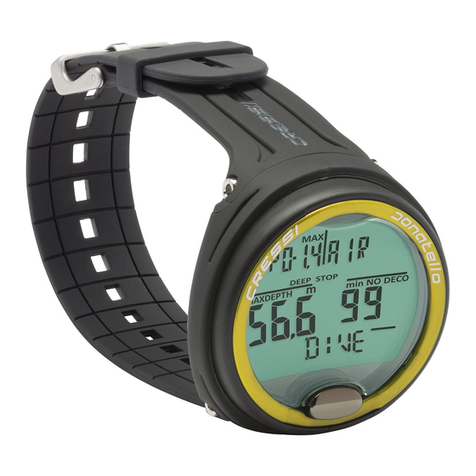
Cressi
Cressi DONATELLO User manual
